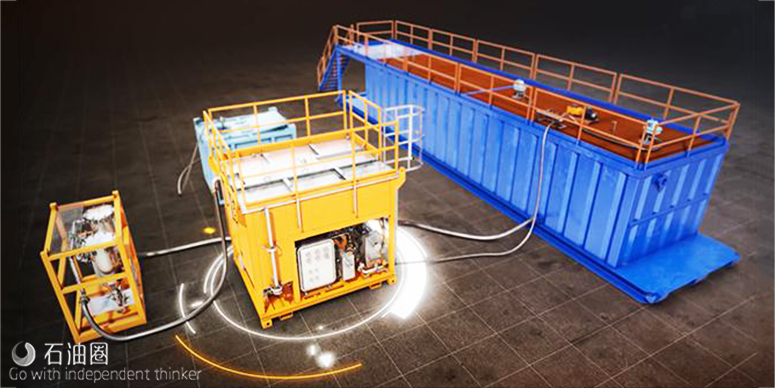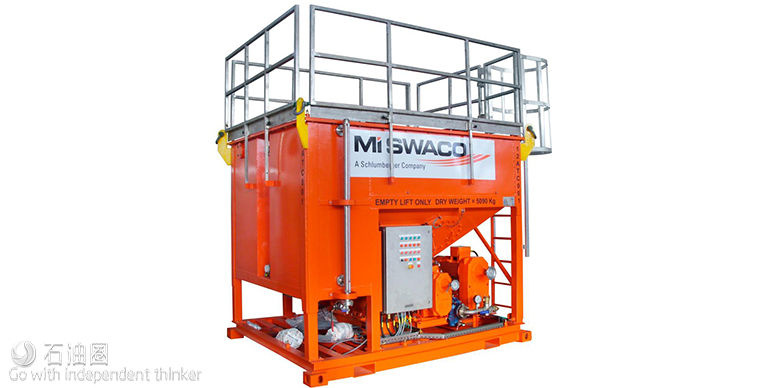Tanks need to be cleaned as solids build up or as fluids need to be changed without cross-
contamination.
Until now, tank cleaning has typically involved laborers equipped with hoses, pressure washers, shovels and squeegees. The task has been slow, labor-intensive, dirty, and potentially dangerous. Having people working inside a filthy tank is not only time consuming,but it poses an unnecessary risk. The economic and QHSE needs for automatic tank cleaning are obvious.
M-I SWACO* has answered this need with a system that is completely automatic, designed to reduce cleaning time and manpower, and to minimize, or even eliminate, confined-space entry. Within the industry’s more stringent QHSE environment, the ATC system improves safety, reduces the number of personnelonboard, significantly reduces waste generation and minimizes downtime during the cleaning process.
Features
(1)Automatic cleaning procedure. Tank Cleaning Machines (TCMs) are installed and configured to each tank’s contours. The cleaning jets follow the pre-programmed paths, requiring no human intervention. A separate, portable slop pump inside the tank either pumps the dirty cleaning water overboard, if such discharge is permitted, or pumps it to a wash-water recycling unit. ATC reduces cleaning time by as much as 70%.
(2)Multiple TCMs operate simultaneously. The automatic tank-cleaning process can involve a number of tank-cleaning machines, which allows work to be completed quickly while reducing downtime and saving money.
(3)Optimally positioned TCMs. With a one-time installation inside the tank, the necessary equipment remains in place for future use.
(4)Custom-designed cleaning pattern. These cleaning tools deliver a higher-density cleaning pattern, directing concentrated cleansing energy at the specific areas where the tank is dirtiest.
(5)Portable to dockside and offshore. The largest ATC skid from M-I SWACO is 94.5 W x 122 H x 165.4 L in. (2,400 x 3,100 x 4,200 mm) and is crane-lifted aboard the rig, boat or dock. This
equipment connects to the TCMs, using lightweight flexible hoses.
(6)Customized cleaning chemistry. M-I SWACO lab tests cleaning fluids to determine the best chemicals to use for each mud. These environmentally acceptable chemicals are tested for biodegradability and deliver optimal results while ensuring operator safety.
(7)Wash-water recycling. The closed-loop system reuses fluid by separating solids from the liquid. The 30 bbl of water/cleaning liquid prepared at the outset of the cleaning operation is used to clean several tanks before it becomes so contaminated with fine solids that it has to be pumped to a waste container and replaced with clean water/cleaning liquid. Once the fine solids have settled out in the waste container (typically overnight), the liquid can be reused again.
How it Works
M-I SWACO optimally positions its Tank Cleaning Machines inside the tank based on the cleaning pattern and analysis of tank geometry. Aportable A utomAtic t Ank c leAning unit is brought onboard when the cleaning job is going to take place. The TCMs are connected to
the ATC skid containing pumps, which send a mixture of surfactant and water to the TCMs.Powerful water jets clean every surface inside the tank following a specially programmed cleaning pattern. A portable slop pump or rig tank pumps transfer the slop back to a wash-water recycling unit inside the ATC unit, where the liquid phase is separated from the solids.Liquid is directed back to the TCMs to be reused as cleaning fluid until it becomes too contaminated by the fine solids. At the end of the operation, cleaning fluid and solid waste, predominantly barite, are safely removed from the installation or reused to build new mud volume. In cases where an overboard permit is in place, the process is simplified.
Specifications
Since each configuration is customized for a specific project, specifications vary. Contact your local M-I SWACO representative to receive additional information on how the A utomAtict Ank cleaning system can save you time and money
Features
(1)Automatic cleaning procedures
(2)Multiple Tank Cleaning Machines(TCMs) operate simultaneously
(3)Optimally positioned TCMs
(4)Custom-designed cleaning pattern
(5)Portable to dock side and offshore
(6)Customized cleaning chemistry
(7)Wash-water recycling
BeneFits
(1)Saves time — quick rig-up
(2)Reduces risk — little or no confined-space entry
(3)Decreases cleaning time by as much as 70%
(4)Easy to operate with a small crew
(5)Minimizes waste
Case study
Premier Oil Reduces Total Pit-Cleaning Time by 90%, Slop Waste Generation by 56% Offshore UK
ATC automatic tank-cleaning technology improves efficiency while reducing personnel confined-space time, North Sea
CHALLENGE
Reduce personnel confined-space time, overall pit-cleaning time, and volume of wastewater created while cleaning the tanks of a semisubmersible rig in the UK sector of the North Sea.
SOLUTION
Deploy the ATC † automatic
tank-cleaning technology.
RESULTS
(1)Decreased slop waste generated by 56%.
(2)Reduced confined-space entry time logged.
(3)Reduced total pit-cleaning time by 90%.
Reduce HSE risk and time requirements for tank cleaning
For performing pit cleaning onboard the Ocean Valiant semisubmersible rig in the UK sector of the North Sea, Premier Oil has historically used traditional tank-cleaning methods, including
high-pressure washers and vacuum units to clean the rig tanks between changing drilling fluids. This process is not only time consuming but also heavily relies on personnel confined-space time
and generates large volumes of waste washwater, which then have to be properly disposed of at a significant expense.
Deploy automaticsolution for tank cleaning
After consulting with Premier Oil about its objectives, M-I SWACO recommended using the ATC automatic tank-cleaning technology, which
comprises a skid-mounted washwater recycling unit and programmable tank-cleaning machines(TCMs) that can be deployed on hard-to-reach areas. The technology requires only 7 m 3 [44 bbl]of washwater, which is continuously cleaned and recycled throughout the cleaning process for reduced wastewater generation.As a result, the technology delivers significant reductions in personnel confined-space time, overall pit-cleaning time, and the volume of wastewater and slop created compared with the traditional methods used in past pit-cleaning operations.
Significantly reduced slop waste and pit-cleaning time without compromising HSE quality
ATC technology was rigged up and cleaned six pits in 56 hours, representing a 90% reduction in cleaning time compared with previous operations using traditional tank-cleaning methods. Only
one hour of confined-space time was necessary to place the TCMs in one of the tanks. A fixed volume of 7 m 3 of washwater with 1% surfactant was used during the cleaning job. By deploying the ATC
technology, Premier Oil achieved a 56% reduction in wastewater generation compared with the cleaning method previously used.
ATC technology generated 56% less waste and reduced total pit-cleaning time by 90% while requiring less confined-space time by personnel.The TCMs can be programmed to target hard-to-reach areas to break down and remove built-up solids in the tank bottoms.

 石油圈
石油圈


